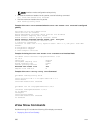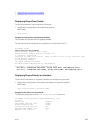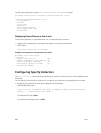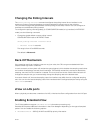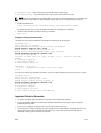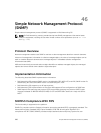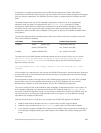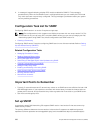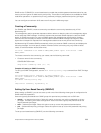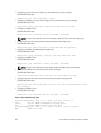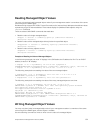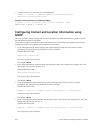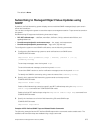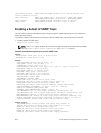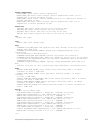
4. A message is logged indicating whether FIPS mode is enabled for SNMPv3. This message is
generated only when the first SNMPv3 user is configured because you can modify the FIPS mode
only when users are not previously configured. This log message is provided to assist your system
security auditing procedures.
Configuration Task List for SNMP
Configuring SNMP version 1 or version 2 requires a single step.
NOTE: The configurations in this chapter use a UNIX environment with net-snmp version 5.4. This
environment is only one of many RFC-compliant SNMP utilities you can use to manage your Dell
Networking system using SNMP. Also, these configurations use SNMP version 2c.
• Creating a Community
Configuring SNMP version 3 requires configuring SNMP users in one of three methods. Refer to Setting
Up User-Based Security (SNMPv3).
Related Configuration Tasks
• Managing Overload on Startup
• Reading Managed Object Values
• Writing Managed Object Values
• Subscribing to Managed Object Value Updates using SNMP
• Copying Configuration Files via SNMP
• Manage VLANs Using SNMP
• Enabling and Disabling a Port using SNMP
• Fetch Dynamic MAC Entries using SNMP
• Deriving Interface Indices
• Monitor Port-channels
Important Points to Remember
• Typically, 5-second timeout and 3-second retry values on an SNMP server are sufficient for both LAN
and WAN applications. If you experience a timeout with these values, increase the timeout value to
greater than 3 seconds, and increase the retry value to greater than 2 seconds on your SNMP server.
• User ACLs override group ACLs.
Set up SNMP
As previously stated, Dell Networking OS supports SNMP version 1 and version 2 that are community-
based security models.
The primary difference between the two versions is that version 2 supports two additional protocol
operations (informs operation and snmpgetbulk query) and one additional object (counter64 object).
868
Simple Network Management Protocol (SNMP)



